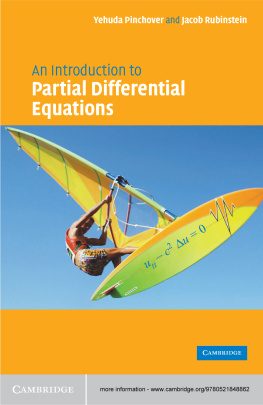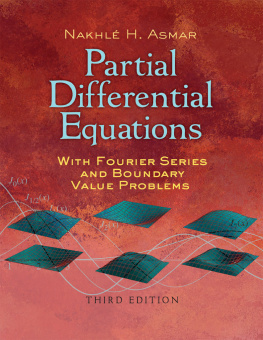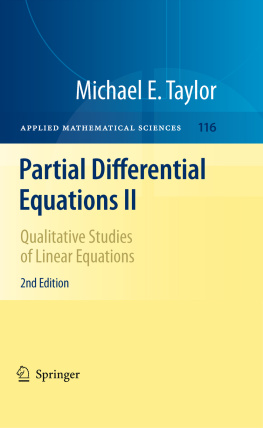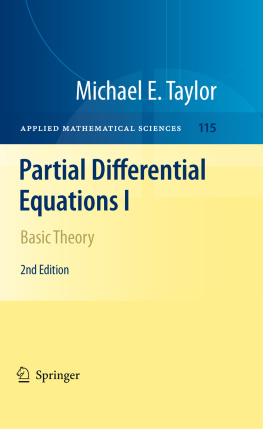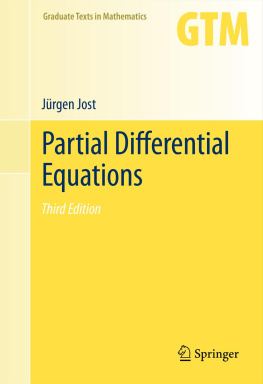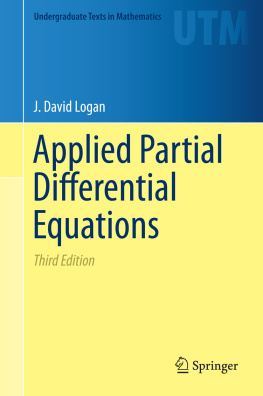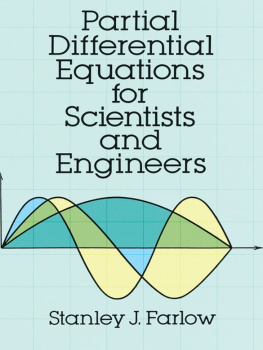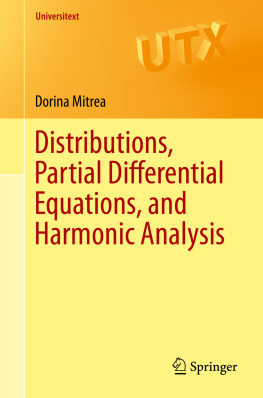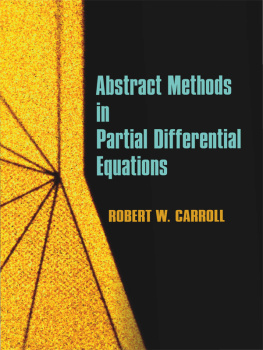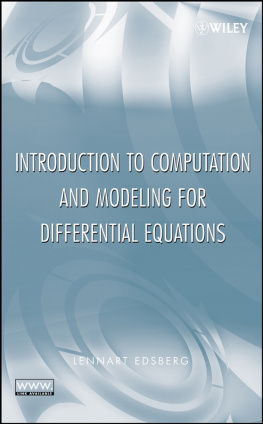Yehuda Pinchover - An Introduction to Partial Differential Equations
Here you can read online Yehuda Pinchover - An Introduction to Partial Differential Equations full text of the book (entire story) in english for free. Download pdf and epub, get meaning, cover and reviews about this ebook. publisher: Cambridge University Press, genre: Children. Description of the work, (preface) as well as reviews are available. Best literature library LitArk.com created for fans of good reading and offers a wide selection of genres:
Romance novel
Science fiction
Adventure
Detective
Science
History
Home and family
Prose
Art
Politics
Computer
Non-fiction
Religion
Business
Children
Humor
Choose a favorite category and find really read worthwhile books. Enjoy immersion in the world of imagination, feel the emotions of the characters or learn something new for yourself, make an fascinating discovery.
- Book:An Introduction to Partial Differential Equations
- Author:
- Publisher:Cambridge University Press
- Genre:
- Rating:4 / 5
- Favourites:Add to favourites
- Your mark:
- 80
- 1
- 2
- 3
- 4
- 5
An Introduction to Partial Differential Equations: summary, description and annotation
We offer to read an annotation, description, summary or preface (depends on what the author of the book "An Introduction to Partial Differential Equations" wrote himself). If you haven't found the necessary information about the book — write in the comments, we will try to find it.
An Introduction to Partial Differential Equations — read online for free the complete book (whole text) full work
Below is the text of the book, divided by pages. System saving the place of the last page read, allows you to conveniently read the book "An Introduction to Partial Differential Equations" online for free, without having to search again every time where you left off. Put a bookmark, and you can go to the page where you finished reading at any time.
Font size:
Interval:
Bookmark:
AN INTRODUCTION TO PARTIAL DIFFERENTIAL EQUATIONS
A complete introduction to partial differential equations, this textbook provides a rigorous yet accessible guide to students in mathematics, physics and engineering. The presentation is lively and up to date, with particular emphasis on developing an appreciation of underlying mathematical theory.
Beginning with basic definitions, properties and derivations of some fundamental equations of mathematical physics from basic principles, the book studies first-order equations, the classification of second-order equations, and the one-dimensional wave equation. Two chapters are devoted to the separation of variables, whilst others concentrate on a wide range of topics including elliptic theory, Greens functions, variational and numerical methods.
A rich collection of worked examples and exercises accompany the text, along with a large number of illustrations and graphs to provide insight into the numerical examples.
Solutions and hints to selected exercises are included for students whilst extended solution sets are available to lecturers from .
AN INTRODUCTION TO PARTIAL DIFFERENTIAL EQUATIONS
YEHUDA PINCHOVER AND JACOB RUBINSTEIN

CAMBRIDGE UNIVERSITY PRESS
Cambridge, New York, Melbourne, Madrid, Cape Town, Singapore, So Paulo, Delhi, Mexico City
Cambridge University Press
The Edinburgh Building, Cambridge CB2 8RU, UK
www.cambridge.org
information on this title: www.cambridge.org/9780521848862
Cambridge University Press 2005
This publication is in copyright. Subject to statutory exception and to the provisions of relevant collective licensing agreements, no reproduction of any part may take place without the written permission of Cambridge University Press.
First published 2005
7th printing 2012
Printed and bound by MPG Books Group, UK
A catalog record for this publication is available from the British Library
ISBN 978-0-521-84886-2 Hardback
ISBN 978-0-521-61323-1 Paperback
Cambridge University Press has no responsibility for the persistence or accuracy of URLs for external or third-party internet websites referred to in this publication, and does not guarantee that any content on such websites is, or will remain, accurate or appropriate. Information regarding prices, travel timetables and other factual information given in this work are correct at the time of first printing but Cambridge Universtiy Press does not guarantee the accuracy of such information thereafter.

Contents
Preface
This book presents an introduction to the theory and applications of partial differential equations (PDEs). The book is suitable for all types of basic courses on PDEs, including courses for undergraduate engineering, sciences and mathematics students, and for first-year graduate courses as well.
Having taught courses on PDEs for many years to varied groups of students from engineering, science and mathematics departments, we felt the need for a textbook that is concise, clear, motivated by real examples and mathematically rigorous. We therefore wrote a book that covers the foundations of the theory of PDEs. This theory has been developed over the last 250 years to solve the most fundamental problems in engineering, physics and other sciences. Therefore we think that one should not treat PDEs as an abstract mathematical discipline; rather it is a field that is closely related to real-world problems. For this reason we strongly emphasize throughout the book the relevance of every bit of theory and every practical tool to some specific application. At the same time, we think that the modern engineer or scientist should understand the basics of PDE theory when attempting to solve specific problems that arise in applications. Therefore we took great care to create a balanced exposition of the theoretical and applied facets of PDEs.
The book is flexible enough to serve as a textbook or a self-study book for a large class of readers. The first seven chapters include the core of a typical one-semester course. In fact, they also include advanced material that can be used in a graduate course. ).
The first eight chapters mainly discuss PDEs in two independent variables. shows how the methods of the first eight chapters are extended and enhanced to handle PDEs in higher dimensions. Generalized and weak solutions are presented in many parts of the book.
Throughout the book we illustrate the mathematical ideas and techniques by applying them to a large variety of practical problems, including heat conduction, wave propagation, acoustics, optics, solid and fluid mechanics, quantum mechanics, communication, image processing, musical instruments, and traffic flow.
We believe that the best way to grasp a new theory is by considering examples and solving problems. Therefore the book contains hundreds of examples and problems, most of them at least partially solved. Extended solutions to the problems are available for course instructors using the book from . We also include dozens of drawing and graphs to explain the text better and to demonstrate visually some of the special features of certain solutions.
It is assumed that the reader is familiar with the calculus of functions in several variables, with linear algebra and with the basics of ordinary differential equations. The book is almost entirely self-contained, and in the very few places where we cannot go into details, a reference is provided.
The book is the culmination of a slow evolutionary process. We wrote it during several years, and kept changing and adding material in light of our experience in the classroom. The current text is an expanded version of a book in Hebrew that the authors published in 2001, which has been used successfully at Israeli universities and colleges since then.
Our cumulative expertise of over 30 years of teaching PDEs at several universities, including Stanford University, UCLA, Indiana University and the Technion Israel Institute of Technology guided to us to create a text that enhances not just technical competence but also deep understanding of PDEs. We are grateful to our many students at these universities with whom we had the pleasure of studying this fascinating subject. We hope that the readers will also learn to enjoy it.
We gratefully acknowledge the help we received from a number of individuals. Kristian Jenssen from North Carolina State University, Lydia Peres and Tiferet Saadon from the Technion Israel Institute of Technology, and Peter Sternberg from Indiana University read portions of the draft and made numerous comments and suggestions for improvement. Raya Rubinstein prepared the drawings, while Yishai Pinchover and Aviad Rubinstein assisted with the graphs. Despite our best efforts, we surely did not discover all the mistakes in the draft. Therefore we encourage observant readers to send us their comments at .
Introduction
1.1 Preliminaries
A partial differential equation (PDE) describes a relation between an unknown function and its partial derivatives. PDEs appear frequently in all areas of physics and engineering. Moreover, in recent years we have seen a dramatic increase in the use of PDEs in areas such as biology, chemistry, computer sciences (particularly in relation to image processing and graphics) and in economics (finance). In fact, in each area where there is an interaction between a number of independent variables, we attempt to define functions in these variables and to model a variety of processes by constructing equations for these functions. When the value of the unknown function(s) at a certain point depends only on what happens in the vicinity of this point, we shall, in general, obtain a PDE. The general form of a PDE for a function
Next pageFont size:
Interval:
Bookmark:
Similar books «An Introduction to Partial Differential Equations»
Look at similar books to An Introduction to Partial Differential Equations. We have selected literature similar in name and meaning in the hope of providing readers with more options to find new, interesting, not yet read works.
Discussion, reviews of the book An Introduction to Partial Differential Equations and just readers' own opinions. Leave your comments, write what you think about the work, its meaning or the main characters. Specify what exactly you liked and what you didn't like, and why you think so.

